
HOT DESERT TIPS
There are three kinds of deserts; mountainous, rocky and sandy. And the reason why they're called deserts is simple... NO ONE LIVES THERE, IT'S DESERTED LAND! And the reason why it's deserted is because there is no water, and where you find no water you find no vegetation growing, and where there is no vegetation, no animals will want to live there. And if there's no water, no vegetation and no animals, then no humans can survive there. How's that for a definition of a desert? Pretty good, huh?
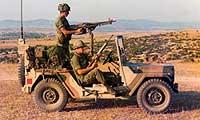 |
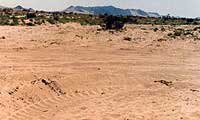 |
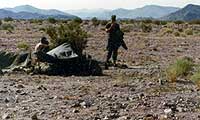 |
Mountain Desert - Turkey |
Sandy Desert - 29 Palms, CA |
Rocky Desert - Ft. Irwin, CA |
Deserts are normally very hot and bright during the day and very cold and clear at night. And it will usually take the average person about 10 (+/-) days to fully adapt and adjust to a desert environment which you'll spend most of your time fighting the scorching sun and heat during the day, the cold tempertures at night, constant thirst and always in search of water, shade and avoiding danger reptiles.
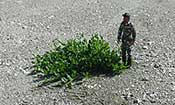 |
In a deserts heat comes from several directions, from the sun, off the ground and sometimes from the wind too. Without water and shade you can only live for so long before collapsing from heat and dehydration. And because your body is made up of about 75% water, whatever is lost thru sweat, urination, etc, it must be replaced so your body temperture, kidneys and brain will function properly. And so wthout water the first thing that will malfuction will be your kidneys, and after this starts to malfunction it will cause everything else in your body to break down and collapse. |
The average person needs about 4 quarter / 6 - 8 glasses of water a day in a non-desert environment. But the taller & heavier you are and the hotter it is the more water you'll need to drink to maintain your health. To reduce thirst and dehydration in a desert, you need to keep out of the sun during the day by staying in the shade and try doing most of your traveling at night or just as the sun is coming up or going down. And most important, if you don't have any or very little water, don't eat anything because it will make you even more thirsty and dehydrated. To keep your mind off not having any water, try the old cowboy trick of sucking on a small stone or a piece of grass.
Should you encounter any critters like desert spiders, scorpions and centipedes, very few of them are really poisonous but they can still give you a very nasty painful bite.
While almost all desert snakes are poisonous, the good news is they spend most of their time hiding during the day to avoid the hot sun by staying under rocks and rock ledges. And the only time they crawl out is when the sun is down to look for food like mice & rodents. But then when it starts to get a little bit too cool.they will start to look for a warm place to stay like back around rocks, rock ledges or inside somebody's sleeping gear.
Should you become a survivor of a disable vehicle or down aircraft, stay with it as it will be easier for a SAR (search and rescure) party to spot it then to try to find someone wandering around aimlessly in a desert. But during the day stay out of the vehicle or aircraft to avoid being "baked liked a patato" and instead find or set up some type of shade away from it and only return back to it after the sun has gone down for warmth and protection.
|
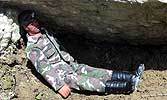 |
Should you decide to leave a disabled vehicle or crash site, always grab a few useful things that will provide you shade during the day, warmth at night and something that will hold water should you locate any.
To avoid roaming aimlessly and in circles, pick a direction, any damn direction and stay on that course until you see signs of civilization or water, and only then should you change your direction of travel.
And no matter how hot it gets during the day, never remove and discard any of your clothing. You clothes will not only protect you from being scorched & burnt during the day but provide you warmth & protection at night when the temperture drops rapidly.
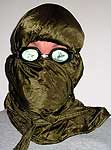 |
Should you find yourself in a sandstorm and you can't find any shelter, lie down on the ground, stomach & head down in the opposite direction of the wind. And if you don't have anything to place over your head, pull up your shirt, a little bit of protection is better than no protection at all. |
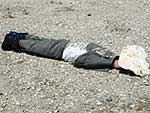 |
These are just a few of the many facts & tips that I've learned and practiced in a desert, and I'm certain they will help you too. Check out my US Army Ranger desert survival training photos below.
 
Wilderness Survival Skills > Wilderness Survival Tips > Here
Back to top of page
E-MAIL THIS SITE TO A FRIEND |

